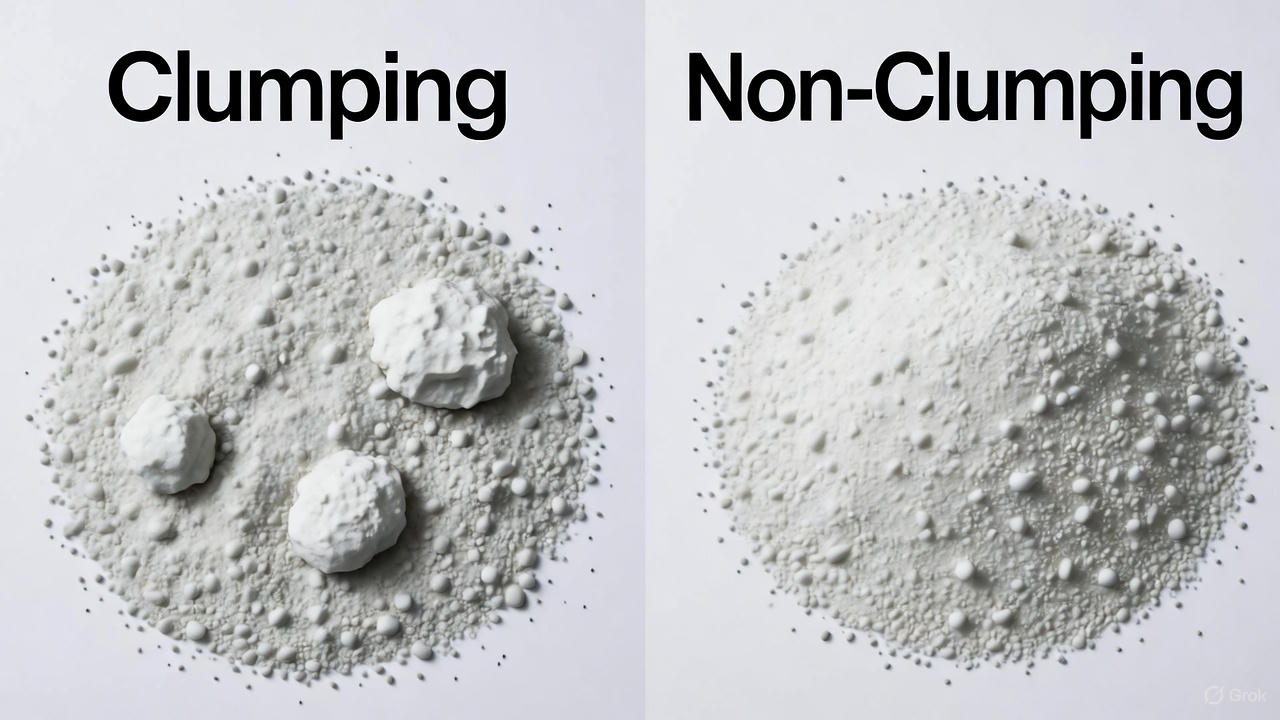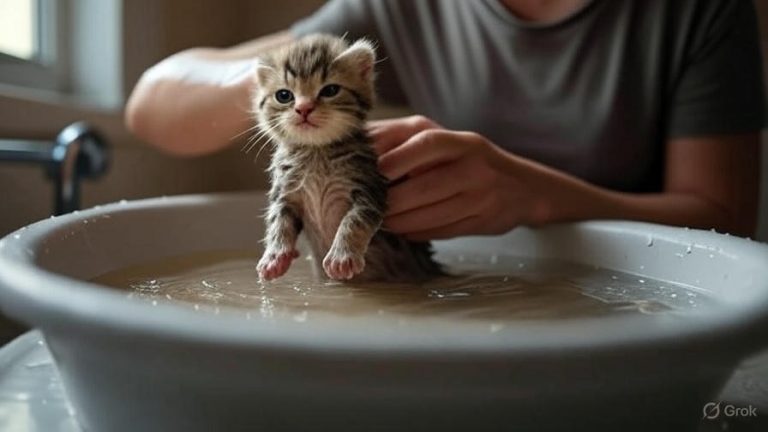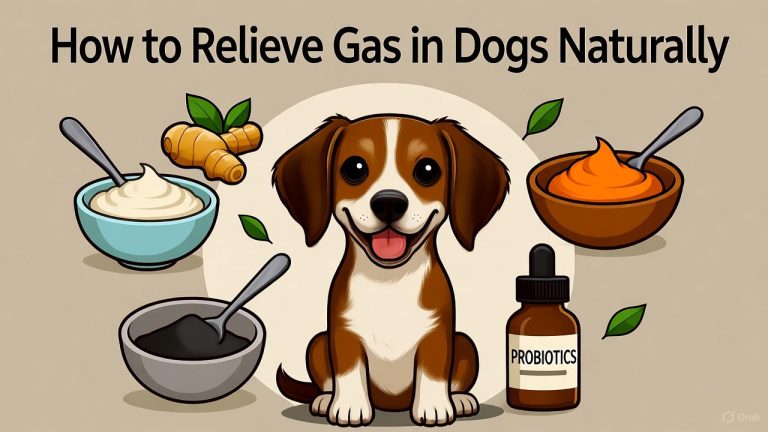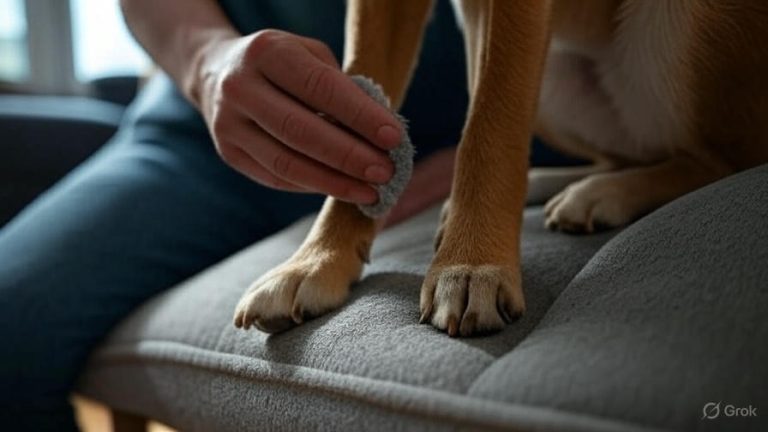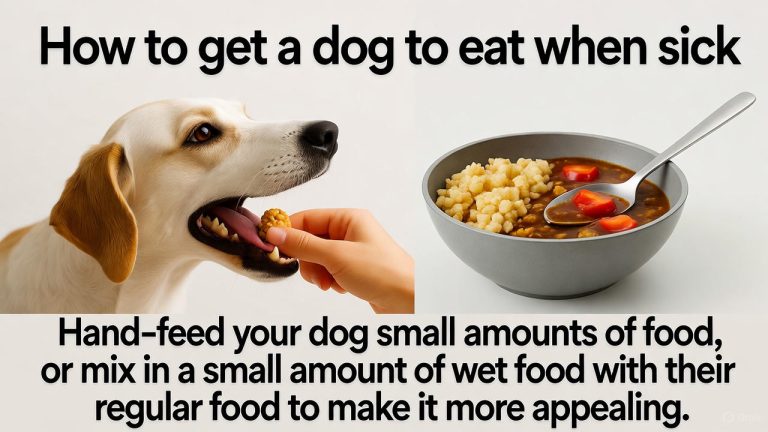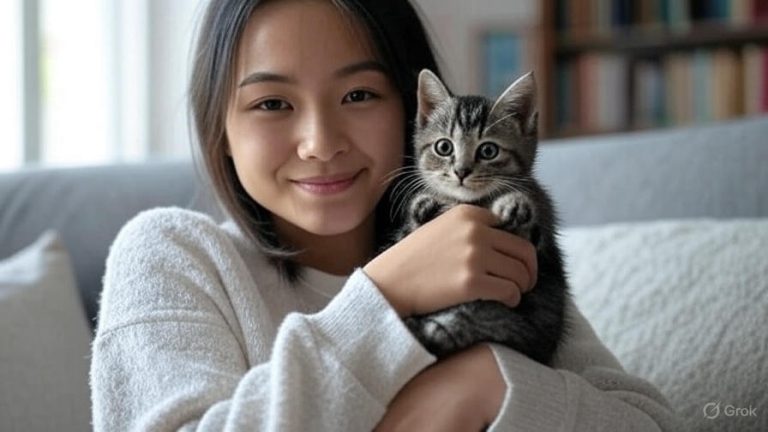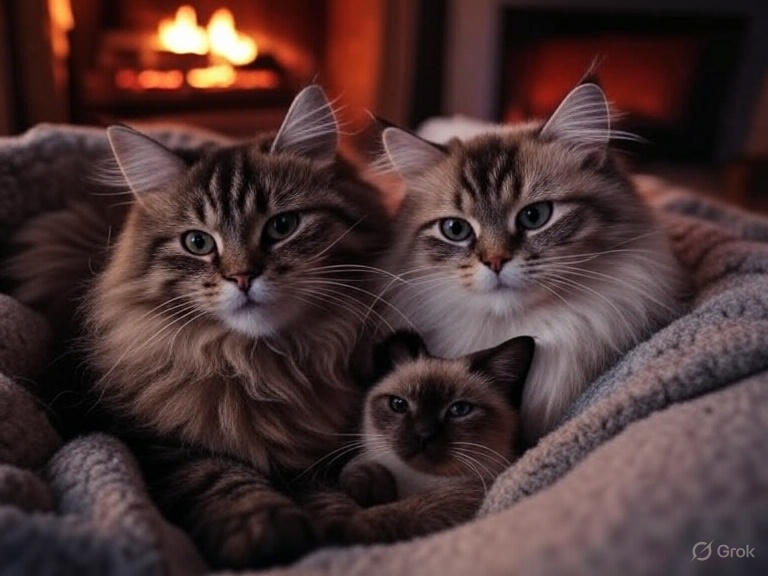Clumping vs Non-Clumping Cat Litter
Every cat owner faces the same question when they walk down the pet supply aisle: clumping or non-clumping litter? This decision affects your daily cleaning routine, your budget, and most importantly, your cat’s comfort and health.
The battle between these two types of cat litter has raged for decades. Each side has passionate supporters who swear by their preferred option. Today, we’ll break down everything you need to know to make the right choice for your feline friend.
What Makes Clumping Litter Different?
Clumping cat litter contains bentonite clay, a natural material that binds together when it contacts moisture. The moment your cat uses the litter box, the wet areas form solid clumps that you can scoop out easily.
This type of litter revolutionized the pet care industry when it first appeared in the 1980s. Before that, cat owners had to change entire litter boxes multiple times per week. Now, daily scooping keeps the box fresh for longer periods.
The clumping action happens through a scientific process. Bentonite clay has amazing absorbent properties. When urine hits the litter, the clay particles swell and stick together. This creates a firm ball that seals in moisture and odor.
Most clumping varieties use sodium bentonite clay as their base ingredient. Some brands add other materials like corn, wheat, or silica to improve performance. The result is a litter that makes waste removal quick and straightforward.
How Non-Clumping Litter Works
Non-clumping litter takes a different approach to managing your cat’s bathroom needs. This type absorbs liquid waste but doesn’t form solid masses. The urine soaks into the granules and stays there until you replace all the litter.
Clay-based non-clumping litter has been around since the 1940s. Ed Lowe, an American entrepreneur, discovered that fuller’s earth clay worked better than sand or ashes for cats. This discovery launched the modern cat litter industry.
The absorption process is simple. Each granule of non-clumping litter acts like a tiny sponge. It soaks up moisture and traps it inside. Solid waste sits on top of the litter, which you remove daily with a scoop.
Non-clumping options include clay litter, crystal litter, recycled paper pellets, and pine litter. Each material offers different absorption rates and odor control levels. Some cat owners prefer these alternatives because they worry about dust or chemicals in clumping formulas.
The Convenience Factor
Daily maintenance matters when you own a cat. Let’s talk about how much time and effort each litter type requires.
Clumping litter wins hands down for daily convenience. You spend just two or three minutes per day scooping out the solid clumps. The remaining clean litter stays in the box. You top it off with fresh litter as needed, and a complete box change happens only once a month or less.
Non-clumping litter demands more frequent full changes. Since the urine disperses throughout the litter instead of forming removable clumps, the entire box becomes saturated over time. Most cat owners need to dump and refill the whole litter box every week or two.
The scooping process also differs. With clumping litter, you can see exactly what needs removal. The clumps are obvious. Non-clumping litter makes this harder because you can’t always tell which areas are soiled. You end up removing solid waste daily but dealing with wet litter that stays mixed with the clean granules.
Think about your lifestyle. Do you travel frequently? Clumping litter handles a few days better than non-clumping types. A cat sitter can easily maintain a clumping litter box with quick daily scoops. Non-clumping boxes might need a complete change during a long weekend trip.
Odor Control Comparison
Nobody wants their home smelling like a litter box. Odor control is a top priority for every cat parent.
Clumping litter excels at trapping smells. When urine clumps immediately, it seals the ammonia smell inside. You remove these odor-containing clumps during your daily scoop. The fresh litter left behind stays relatively odor-free.
Many clumping brands add baking soda, activated charcoal, or other odor-fighting ingredients. These additions boost the natural smell-blocking properties of the clay. Some varieties include perfumes or scents, though many cats dislike heavily fragranced litters.
Non-clumping litter faces a bigger challenge with odor management. The urine spreads through the litter and continues to produce ammonia gas as it sits there. Even with daily solid waste removal, the wet litter creates persistent bathroom smells.
Crystal litter, a non-clumping option, performs better than traditional clay at odor control. The silica gel crystals trap odor molecules more effectively. However, crystal litter costs significantly more than regular non-clumping clay.
Multi-cat households notice the odor difference most. With several cats using the same box, clumping litter keeps smells under control much better. Non-clumping litter becomes overwhelmed quickly when multiple cats contribute waste throughout the day.
Cost Analysis
Your wallet cares about this decision too. Let’s compare the real costs of each litter type.
Non-clumping litter appears cheaper at first glance. A bag costs less than the same size bag of clumping litter. You might pay $5-8 for a 20-pound bag of non-clumping clay versus $10-15 for clumping.
But here’s the catch: you use more non-clumping litter over time. Since you replace the entire box weekly or biweekly, you burn through bags quickly. With clumping litter, you only replace what your cat soils. The rest stays in the box for weeks or months.
Let’s do the math. A single cat household might use one 20-pound bag of clumping litter per month, costing about $12-15. That same household could need two or three bags of non-clumping litter monthly, totaling $15-24. The “cheaper” option ends up costing more.
Premium clumping litters with natural ingredients like corn, wheat, or walnut shells cost more upfront. These can run $20-30 per bag. However, they often last longer than standard clay clumping litters because they form tighter clumps.
Crystal litter represents the most expensive non-clumping option. A bag might cost $15-25 but lasts longer than traditional non-clumping clay. For budget-conscious cat owners, it still doesn’t beat standard clumping litter for overall value.
Dust and Tracking
The mess factor influences your decision. Nobody enjoys sweeping litter off the floor three times a day.
Clumping litter tends to produce more dust than non-clumping options. When you pour it into the box or your cat digs around, fine particles become airborne. This dust settles on nearby surfaces and can irritate respiratory systems in both cats and humans.
Many manufacturers now offer low-dust or dust-free clumping formulas. These cost a bit more but dramatically reduce the powder cloud that appears during litter changes. If dust bothers you or your cat, spending extra for these formulas makes sense.
Tracking happens when litter sticks to your cat’s paws and gets carried throughout your home. Small, fine-grained clumping litters track more than larger granules. You’ll find little litter trails leading away from the box.
Non-clumping litters, especially those with larger pellets, track less. Pine pellets, paper pellets, and crystal litters don’t cling to paws as much as fine clay particles. Your floors stay cleaner around the litter box area.
Some solutions help both types. Litter mats placed outside the box catch particles from your cat’s paws. High-sided or covered litter boxes reduce scatter during enthusiastic digging sessions.
Health and Safety Concerns
Your cat’s wellbeing comes first. Let’s examine the health aspects of both litter types.
Some people worry about clumping litter and kittens. The clay can expand when wet, and if a young kitten ingests it while grooming, it might cause digestive blockages. Most vets recommend waiting until kittens reach 3-4 months old before introducing clumping litter.
Adult cats generally handle clumping litter safely. Bentonite clay is a natural, non-toxic material. Cats would need to consume large amounts to experience any issues. Normal grooming and occasional litter ingestion doesn’t typically cause problems.
Non-clumping litter carries fewer ingestion worries. The granules don’t expand like clumping clay. Kittens can use non-clumping varieties from the time they start litter training around 3-4 weeks old.
Dust from any litter type can affect cats with asthma or respiratory sensitivities. The fine particles irritate airways and trigger breathing problems. Both clumping and non-clumping clay litters produce dust, though the amount varies by brand.
Silica crystal litters are virtually dust-free but contain different concerns. The crystals can be sharp, and some cats dislike walking on them. Ingestion of crystal litter rarely causes issues, but the texture might bother cats with sensitive paws.
Natural litters made from corn, wheat, pine, or paper offer the safest options overall. They produce minimal dust, don’t expand dangerously if eaten, and use renewable resources. Both clumping and non-clumping versions exist in these natural categories.
Environmental Impact
Green-minded cat owners care about their litter’s environmental footprint.
Traditional clay litters, both clumping and non-clumping, come from strip mining. This process damages landscapes and destroys habitats. Bentonite clay is not a renewable resource. We’re literally digging up the earth to fill litter boxes.
Used clay litter creates disposal problems too. It doesn’t break down in landfills. The millions of tons of cat litter discarded annually sit in waste facilities essentially forever. Some areas even prohibit flushing clay litter because it clogs sewer systems.
Clumping litter has a slight edge here because you use less overall. Removing only the soiled portions means less litter ends up in the trash compared to dumping entire boxes of non-clumping litter weekly.
Natural and biodegradable litters offer better environmental solutions. Corn, wheat, pine, walnut shell, and paper litters come from renewable or recycled resources. Many break down in compost bins, though you should never compost litter from cats due to parasite concerns.
Crystal litter falls somewhere in the middle environmentally. Silica gel comes from sand, a plentiful resource. The manufacturing process uses energy, but the long-lasting nature of crystal litter means less frequent disposal.
Some forward-thinking cat owners flush certain types of natural clumping litter. Only specific brands marked as flushable and safe for septic systems should go down the toilet. Never flush clay-based litters or crystal litters.
What Cats Actually Prefer
Your cat gets the final vote. Their preferences matter because a cat who dislikes their litter might refuse to use the box.
Most cats accept both clumping and non-clumping litters without fuss. They care more about cleanliness than litter type. A dirty box of any litter type gets rejected faster than a clean box with less-preferred litter.
Texture plays a big role in feline preferences. Cats instinctively want to bury their waste, so they gravitate toward litters that feel like sand or soil. Fine-grained clumping litter mimics natural digging materials better than large pellets.
Some cats dislike the feeling of clumping litter sticking to their paws when it’s wet. They might step in a fresh clump before it fully hardens. This sensation bothers fastidious cats who keep themselves impeccably clean.
Scented litters often backfire. Cats have sensitive noses, and strong perfumes overwhelm them. What smells “fresh” to humans can smell awful to cats. Unscented varieties of both clumping and non-clumping litters work best for most felines.
Senior cats or those with mobility issues benefit from softer litters. Non-clumping paper pellets or fine clumping clay feel gentler on arthritic paws than harder crystals or rough clay granules.
The transition period matters when you switch litter types. Mix the new litter gradually with the old over 7-10 days. Sudden changes confuse cats and can lead to litter box avoidance.
Special Situations and Recommendations
Different households have different needs. Here’s guidance for specific scenarios.
For multiple cat homes: Clumping litter handles heavy use better. The ability to remove waste multiple times daily keeps boxes acceptable for all your cats. You’ll need multiple litter boxes—the rule is one per cat plus one extra.
For apartments and small spaces: Odor control becomes critical when you can’t escape the smell. Clumping litter with good odor-fighting ingredients wins here. Consider adding an air purifier near the litter box area.
For automatic litter boxes: These devices almost always require clumping litter. The self-cleaning mechanisms rely on formed clumps to separate waste from clean litter. Non-clumping litter doesn’t work in these systems.
For cats with allergies: Dust-free, natural litters help cats with respiratory issues. Look for paper-based, corn-based, or wheat-based options. These come in both clumping and non-clumping formulas.
For declawed cats: Cats without claws need softer litters because their paws are more sensitive. Non-clumping paper pellets or very fine clumping litter works best. Avoid crystals and rough clay granules.
For kittens under 4 months: Use non-clumping litter to prevent blockages from curious youngsters who might eat the litter. Switch to clumping after they mature and stop exploring the box with their mouths.
Making Your Decision
Now you have all the information. How do you decide?
Start by evaluating your priorities. If convenience and odor control top your list, clumping litter makes sense. If you have budget constraints or prefer a more natural product, explore non-clumping alternatives.
Consider your cat’s age and health. Young kittens need non-clumping litter temporarily. Cats with breathing issues need low-dust options. Senior cats appreciate softer textures.
Think about your cleaning style. If you’re diligent about daily scooping, clumping litter rewards your efforts with easy maintenance. If you prefer to dump and refresh weekly, non-clumping litter suits that routine.
Test different brands within your chosen category. Not all clumping litters perform equally. Some form rock-hard clumps while others crumble. Non-clumping litters vary widely in absorption and odor control too.
Buy small bags initially when trying new litters. If your cat rejects your choice, you haven’t wasted money on a giant bag. Watch your cat’s behavior closely during the transition. Signs of litter box avoidance include eliminating outside the box, scratching around the box without entering, or spending less time covering waste.
Many successful cat owners use a hybrid approach. They might use clumping litter in high-traffic boxes and non-clumping litter in less-used boxes. Some use clumping daily and keep non-clumping litter as a backup for times when they run out of their primary choice.
The Bottom Line
Both clumping and non-clumping litters have earned their place in the pet care market. Neither option is universally superior—the best choice depends on your specific circumstances.
Clumping litter offers unmatched convenience and superior odor control. It costs more per bag but provides better long-term value through reduced usage. The daily scooping routine takes minimal time. For busy households, multi-cat homes, and anyone who values convenience, clumping litter delivers.
Non-clumping litter serves specific needs well. It costs less upfront, tracks less, produces less dust in some formulas, and works better for very young kittens. Cat owners who don’t mind more frequent complete changes can save money with non-clumping options, especially if they choose longer-lasting crystal varieties.
Your cat’s happiness matters most. A clean litter box that your cat willingly uses beats any theoretical advantage of one litter type over another. Pay attention to your feline’s preferences and behaviors. They’ll tell you what works through their actions.
The litter box situation in your home affects your quality of life and your cat’s wellbeing. Take time to experiment and find the right solution. Once you discover the perfect litter type and brand for your household, both you and your cat will appreciate the difference every single day.

